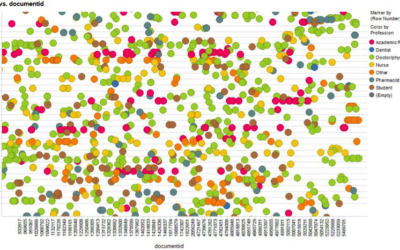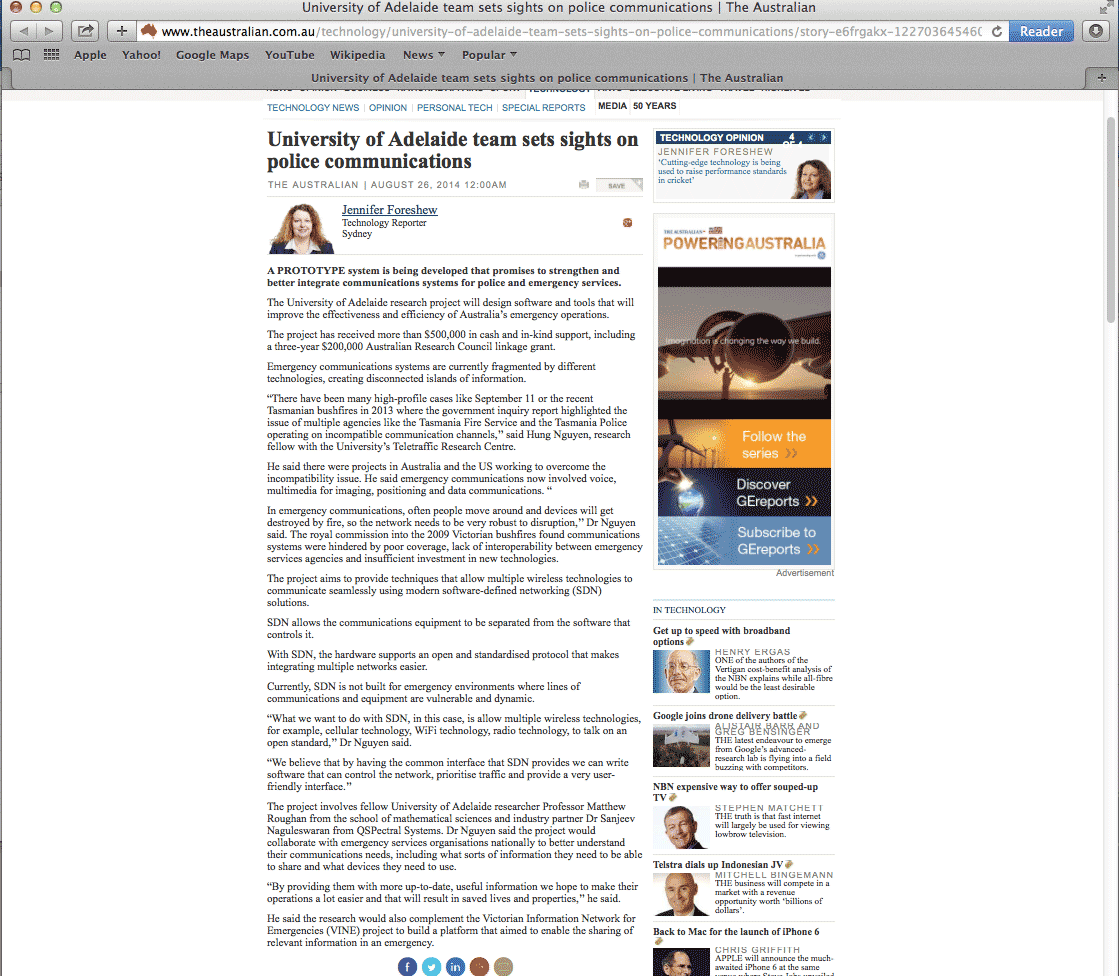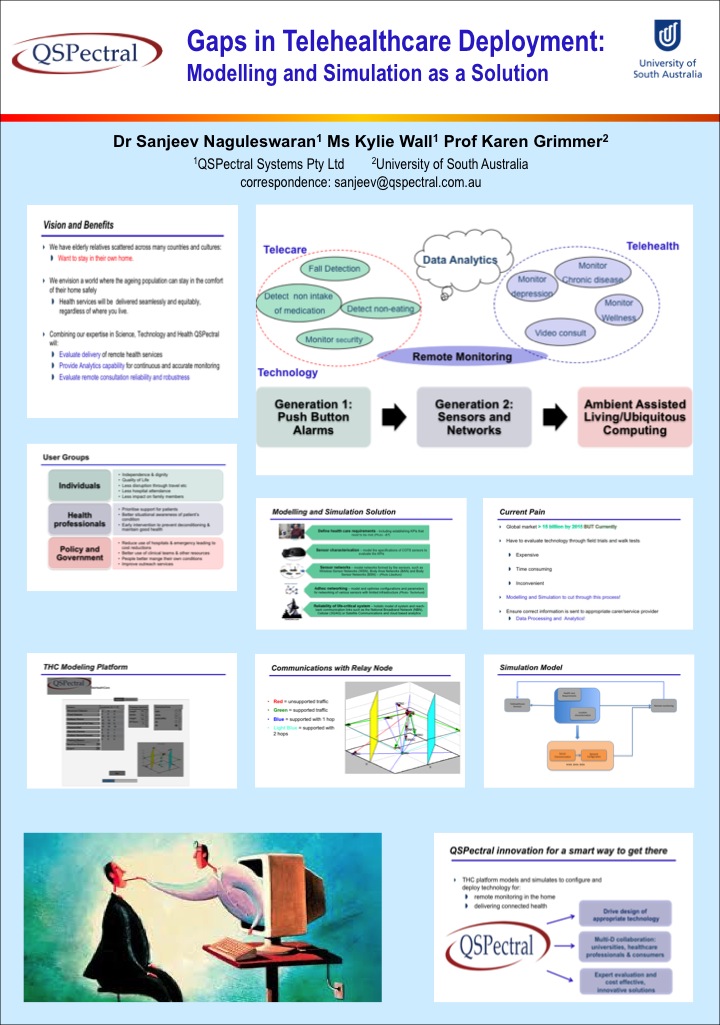News
Clever stuff from QSPectral
We responded to the Trip medical community to help me make sense of all their lovely clickstream data. We used our data science capability to make sense of their clickstream data.
https://blog.tripdatabase.com/2015/07/17/clever-stuff-with-the-help-of-qspectral/
Data Analytics for Organisational Strategy
QSPectral Research Analyst, Sanjeev Naguleswaran describes how data science can help formulate organisational strategy:
https://expert360.com/blog/data-analytics-for-organisational-strategy/
QSPectral ARC linkage project in the Australian
A PROTOTYPE system is being developed that promises to strengthen and better integrate communications systems for police and emergency services.
The University of Adelaide research project will design software and tools that will improve the effectiveness and efficiency of Australia’s emergency operations.
The project has received more than $500,000 in cash and in-kind support, including a three-year $200,000 Australian Research Council linkage grant.
Emergency communications systems are currently fragmented by different technologies, creating disconnected islands of information.
“There have been many high-profile cases like September 11 or the recent Tasmanian bushfires in 2013 where the government inquiry report highlighted the issue of multiple agencies like the Tasmania Fire Service and the Tasmania Police operating on incompatible communication channels,’’ said Hung Nguyen, research fellow with the University’s Teletraffic Research Centre.
He said there were projects in Australia and the US working to overcome the incompatibility issue. He said emergency communications now involved voice, multimedia for imaging, positioning and data communications. “
In emergency communications, often people move around and devices will get destroyed by fire, so the network needs to be very robust to disruption,’’ Dr Nguyen said. The royal commission into the 2009 Victorian bushfires found communications systems were hindered by poor coverage, lack of interoperability between emergency services agencies and insufficient investment in new technologies.
The project aims to provide techniques that allow multiple wireless technologies to communicate seamlessly using modern software-defined networking (SDN) solutions.
SDN allows the communications equipment to be separated from the software that controls it.
With SDN, the hardware supports an open and standardised protocol that makes integrating multiple networks easier.
Currently, SDN is not built for emergency environments where lines of communications and equipment are vulnerable and dynamic.
“What we want to do with SDN, in this case, is allow multiple wireless technologies, for example, cellular technology, WiFi technology, radio technology, to talk on an open standard,’’ Dr Nguyen said.
“We believe that by having the common interface that SDN provides we can write software that can control the network, prioritise traffic and provide a very user-friendly interface.’’
The project involves fellow University of Adelaide researcher Professor Matthew Roughan from the school of mathematical sciences and industry partner Dr Sanjeev Naguleswaran from QSPectral Systems. Dr Nguyen said the project would collaborate with emergency services organisations nationally to better understand their communications needs, including what sorts of information they need to be able to share and what devices they need to use.
“By providing them with more up-to-date, useful information we hope to make their operations a lot easier and that will result in saved lives and properties,’’ he said.
He said the research would also complement the Victorian Information Network for Emergencies (VINE) project to build a platform that aimed to enable the sharing of relevant information in an emergency.
Media Announcements regarding ARC Linkage
QSPectral Presents at SimTecT/SimHealth, Adelaide 2014
The QSPectral Telehelthcare modelling and analytics method developed in collaboration with the International Centre for Allied Health Evidence (iCAHE) at the University of South Australia was presented at SimHealth. The paper was titled:
Gaps in Telehealthcare Deployment: Modelling and Simulation as a Solution
by
Dr Sanjeev Naguleswaran, Kylie Wall and Prof. Karen Grimmer
QSPectral Awarded ARC Linkage Grant
QSPectral was awarded an ARC Linkage grant to collaborate with researchers at the University of Adelaide.
Software Defined Networking: Transforming Emergency Communications
Project Summary
The project aims to improve the effectiveness and efficiency of Australia’s emergency operations, for example, bushfire
and rescue missions, by providing robust and integrated communications systems for police and the emergency services. Emergency communications systems are currently fragmented by the different technologies, creating disconnected islands of information. The project aims to provide techniques that allow multiple wireless technologies to communicate seamlessly using modern software-defined networking solutions.
MiLCIS 2013
QSPectral consultant Sanjeev Naguleswaran is co-authoring a paper to be presented at MiLCIS 2013 (www.milcis.com.au).
This paper is based on work done at the Centre for Defence Communication and Information Networking and presents “A New Methodology for the Identification of Operational Stress
Points and Assessment of Technology Solutions”
Fraud Analytics
Sanjeev obtained a CSIRO grant to develop fraud analytics for Acumen Data at CDCIN, University of Adelaide. This project has been nominated for Adelaide Innovations Champion 2013.
You can view the project description here http://www.adelaideresearch.com.au/adelaideinnovation/innovationnominees/project-7/ and cast your vote at http://www.adelaideresearch.com.au/adelaideinnovation/innovationnominees/ for Acumen Data.
Paper at NATO Modeling and Simulation Group Symposium
QSPectral consultant Sanjeev Naguleswaran is co-authoring a paper to be presented at the 2013 NATO Modeling & Simulation Group (NMSG) Symposium.
This paper is based on work done at the Centre for Defence Communication and Information Networking – “C3 Stress Relief: A new methodology for identifying operational C3 stress points and emerging technology solutions”
SiMTECT 2013
Dr Sanjeev Naguleswaran, Principal consultant at QSPectral, will be presenting work in Telehealthcare at SiMTECT/SimHealth 2013 on Thursday the 19th of September at the Brisbane convention centre.
Modelling and Simulation for Remote Monitoring in Telehealthcare from Sanjeev Naguleswaran




Recent Comments